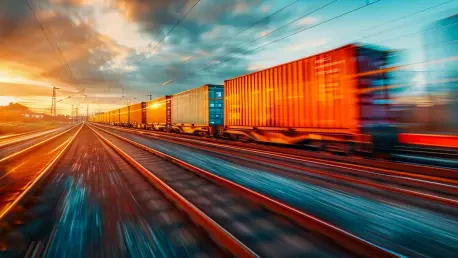Introduction: The Backbone of Global Trade
Imagine a world where goods traverse continents in days rather than weeks, cutting through the clutter of congested highways with unmatched efficiency—rail freight makes this a reality, moving over 40% of the world’s cargo by volume annually. This staggering statistic underscores the indispensable role of rail in sustaining global trade, especially as demand for sustainable and cost-effective logistics solutions surges. Rail freight stands as a critical pillar in reducing carbon footprints while supporting economic growth across diverse regions. This analysis delves into the transformative innovations shaping the industry, from cutting-edge technology and infrastructure advancements to digital transformations and strategic partnerships. It also explores real-world applications, gathers expert insights, and examines the future trajectory of these developments, culminating in a reflection on their broader implications for global logistics.
Emerging Innovations in Rail Freight Technology and Infrastructure
Surge in Intermodal Solutions
The rise of intermodal transport solutions marks a pivotal shift in rail freight, with terminals and services expanding rapidly to meet market needs. Data from industry leaders like Union Pacific highlights a remarkable 20% reduction in transit times for container shipments between California and Chicago, showcasing how intermodal hubs enhance speed and reliability. This growth reflects a broader trend of integrating rail with other modes of transport to offer seamless logistics, positioning rail as a formidable competitor to road shipping.
Investments in intermodal infrastructure continue to scale, with projections indicating significant capacity boosts along key trade routes. For instance, reports suggest that the Middle Corridor, a vital link between Asia and Europe, could see over 400 block trains annually in the near future, driven by substantial funding and international cooperation. Such developments signal a robust commitment to expanding rail’s market share in global freight movement.
Real-World Applications of Infrastructure and Technology
Concrete examples of these innovations are evident in regions striving for logistics modernization. In East Africa, Tanzania’s Kwala International Logistics Hub, paired with a standard gauge railway service from Dar es Salaam to Dodoma, exemplifies how targeted infrastructure projects can elevate regional connectivity and economic prospects. This initiative streamlines cargo flow, reducing dependency on slower, less sustainable transport options.
Elsewhere, North America and Europe showcase similar advancements with facilities designed to challenge trucking dominance. BNSF’s newly established intermodal terminal in Salt Lake City, developed alongside Patriot Rail and the Utah Inland Port Authority, boosts capacity for containerized goods in the western United States. Simultaneously, Hungary’s Debrecen Intermodal Terminal, managed by GySEV Cargo, underscores Europe’s focus on integrated transport networks, offering efficient alternatives for shippers and reducing road congestion.
Digital Transformation and Strategic Partnerships in Rail Freight
Adoption of Digital Tools for Operational Efficiency
Digitalization is revolutionizing rail freight operations, enhancing transparency and streamlining supply chain management. A notable example is the merger between Rotterdam-based Simply Deliver and Rail-Flow Group, which combines expertise in road-rail logistics software to create end-to-end visibility for intermodal transport. Such tools empower operators to optimize routes, track shipments in real time, and minimize delays, fundamentally transforming logistics efficiency.
Industry projections point to widespread adoption of digital solutions, with many rail operators integrating automation and data analytics into their workflows. This shift not only improves operational synergy but also addresses customer demands for faster, more reliable services. As digital platforms become standard, their impact on reducing costs and enhancing decision-making processes becomes increasingly evident across the sector.
Collaborative Ventures Enhancing Global Connectivity
Strategic partnerships are reshaping rail freight by fostering cross-border connectivity and trade diversification. The Middle Corridor Multimodal joint venture, involving national railways from China, Azerbaijan, Kazakhstan, and Georgia, stands as a prime illustration of international collaboration. This initiative aims to streamline freight movement between Asia and Europe, offering an alternative to traditional routes and bolstering supply chain resilience.
In North America, consolidation through acquisitions also plays a vital role in expanding network reach. Regional Rail’s acquisition of Minnesota Commercial Railway, which connects to major Class I networks in the Twin Cities area, demonstrates how such moves enhance service coverage and operational scale. These collaborations, whether global or regional, highlight a unified push toward integrated and expansive rail networks.
Expert Perspectives on Rail Freight Evolution
Insights on Industry Transformation
Industry leaders emphasize the profound impact of intermodal growth, digital tools, and international corridors on rail freight’s evolution. Analysts note that the expansion of intermodal services is not just a trend but a necessity to meet rising consumer expectations for speed and sustainability in logistics. These advancements are seen as game-changers in positioning rail as a preferred mode for long-haul cargo transport.
Addressing Challenges in Expansion
However, experts also caution against potential pitfalls, such as the need to balance rapid expansion with safety and reliability. Initiatives like the Hazardous Materials Training Institute in Florida, launched through a partnership between CSX and Florida State College at Jacksonville, are cited as critical steps in enhancing emergency preparedness. Such programs underscore the industry’s commitment to mitigating risks associated with handling sensitive cargo.
Role of Policy and Government Support
Government backing is frequently highlighted as a linchpin for sustained growth in rail freight. South Africa’s substantial financial guarantee to Transnet, ensuring liquidity for the state-owned operator, is often referenced as a model of how policy support can stabilize and propel industry advancements. Experts argue that without such interventions, many rail operators would struggle to fund necessary upgrades and expansions, hindering progress.
Future Outlook for Global Rail Freight Innovations
Anticipated Developments in Networks and Automation
Looking ahead, the rail freight sector is poised for further transformation with the continued expansion of intermodal networks and the integration of advanced automation. Emerging technologies, such as autonomous trains and predictive maintenance systems, could redefine operational efficiency, slashing costs and downtime. These innovations promise to keep rail competitive in an ever-evolving logistics landscape.
Benefits and Challenges on the Horizon
The potential benefits of these advancements are substantial, including significantly reduced carbon emissions and accelerated delivery timelines. However, challenges loom, particularly around merger scrutiny involving major players like Union Pacific and Norfolk Southern, which could stifle competition if not carefully regulated. Striking a balance between consolidation and market diversity remains a critical concern for stakeholders.
Broader Implications for Global Trade
On a larger scale, rail freight innovations hold the power to strengthen global trade resilience by diversifying transport corridors like the Middle Corridor. These alternative routes mitigate geopolitical risks and enhance supply chain stability. Yet, the risk of over-consolidation in certain markets could limit options for shippers, necessitating vigilant oversight to ensure equitable growth and accessibility in the industry.
Conclusion: Reflecting on a Transformative Journey
Looking back, the journey of global rail freight innovations reveals a dynamic landscape where intermodal solutions, digital advancements, strategic collaborations, and policy support converge to redefine logistics. The emphasis on sustainable transport alternatives and enhanced connectivity stands out as a defining achievement. Moving forward, stakeholders must prioritize investments in cutting-edge technologies and foster international partnerships to sustain momentum. Addressing regulatory challenges and safety concerns will be essential to maintain trust and efficiency. As this sector continues to evolve, a proactive approach to innovation and collaboration will shape a more resilient and interconnected global trade network for generations to come.









